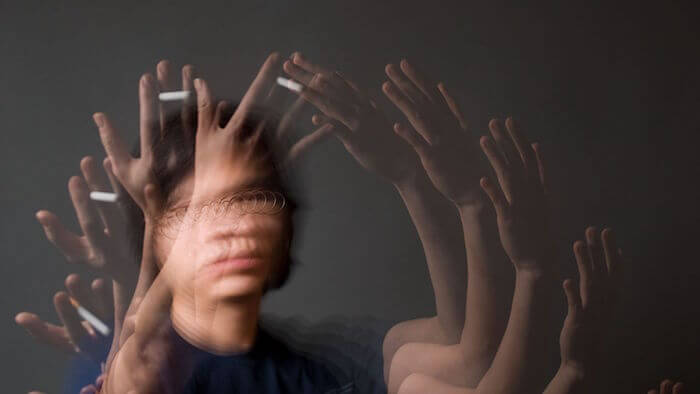Agnosia: The Inability to Recognize Familiar Things

What would happen if one day you couldn’t tell an umbrella from a cane? Or what if you could no longer recognize objects based on your sense of touch? If anything like this happens to you regularly, you might be suffering from some type of agnosia, or the inability to recognize the information that you perceive through your five senses.
The word agnosia was introduced by Sigmund Freud in 1891. All of your senses might function correctly, but your brain is incapable of recognizing the information that the senses take in from the environment. Stroke, brain injury, and oxygen deprivation can all cause the type of damage that leads to agnosia.
The word agnosia comes from Ancient Greek and means “absence of knowledge.”
Types of agnosia
Everyone who suffers from agnosia goes through a period of frustration, powerlessness, and anxiety due to being unable to interpret what they see, feel, or taste. It’s like the senses and the brain stop speaking the same language. Like they get disconnected.
For this reason, it’s common and understandable for people with agnosia to develop depression. After all, the disconnect makes it hard for them to perceive and interact with the world.

It’s important to point out that having agnosia doesn’t mean that all the senses suddenly become impaired. There are many different types of agnosia, including:
- Visual: the inability to name and categorize objects based on what they look like. For example, being unable to look at a tennis racket and recognize that it’s a racket.
- Auditory: difficulty recognizing sounds. For example, not being able to distinguish between different instruments in a song.
- Tactile: the inability to identify objects through touch. For example, not being able to differentiate a spoon from a fork just by touching it.
- Spatial: difficulty orienting oneself and creating mental maps. For example, being unable to draw a plan of one’s own house.
- Motor: difficulty remembering and executing learned movements. Also known as apraxia. For example, trying to put a T-shirt on the legs instead of the torso.
- Bodily: problems identifying one’s own body. For example, thinking that one’s own extremities belong to another person.
“I was a ghost, I looked at myself and saw only blurred features, as if they were just traces. I saw a ghost lost in the mirror, I didn’t know if what I was touching was my mouth, my ear, or my nose.”
-Esther Chumillas, who suffers from visual agnosia as a result of meningitis-

The deceitful brain
Now that we’ve reviewed types of agnosia, we should mention that usually it’s just one sense that’s affected. That is, someone with motor agnosia probably doesn’t also suffer from auditory agnosia. But there are always exceptions.
The reason people usually only suffer from one type is because it’s usually just one part of the brain that’s damaged. If there’s a certain type of damage to the temporal lobe, the person will probably have auditory agnosia. On the other hand, damage to the occipital lobe will likely cause visual or spatial agnosia.
If two areas of the brain are damaged, however, it’s possible to have more than one type of agnosia. But does it have a cure? Is there hope for substantial improvement when the brain is that damaged?
The answer is yes, there is hope for improvement. This is thanks to the tools that occupational therapy, speech therapy, and neurologists can offer. Cognitive rehabilitation, for one, teaches them certain tricks to recognize faces, like focusing on the most distinctive features of the face and learning to notice them.
Agnosia is not a very well-known term. However, much more is known about this condition today then ever before. Because of professionals who dedicate themselves to researching and learning more about agnosia there are now resources and tools that can make the lives of those who suffer from it much easier, even if their cases cannot be completely cured.
“Sometimes I’m not sure where I should turn. I get lost all the time.”
-Anne, who suffers from spatial agnosia-
What would happen if one day you couldn’t tell an umbrella from a cane? Or what if you could no longer recognize objects based on your sense of touch? If anything like this happens to you regularly, you might be suffering from some type of agnosia, or the inability to recognize the information that you perceive through your five senses.
The word agnosia was introduced by Sigmund Freud in 1891. All of your senses might function correctly, but your brain is incapable of recognizing the information that the senses take in from the environment. Stroke, brain injury, and oxygen deprivation can all cause the type of damage that leads to agnosia.
The word agnosia comes from Ancient Greek and means “absence of knowledge.”
Types of agnosia
Everyone who suffers from agnosia goes through a period of frustration, powerlessness, and anxiety due to being unable to interpret what they see, feel, or taste. It’s like the senses and the brain stop speaking the same language. Like they get disconnected.
For this reason, it’s common and understandable for people with agnosia to develop depression. After all, the disconnect makes it hard for them to perceive and interact with the world.

It’s important to point out that having agnosia doesn’t mean that all the senses suddenly become impaired. There are many different types of agnosia, including:
- Visual: the inability to name and categorize objects based on what they look like. For example, being unable to look at a tennis racket and recognize that it’s a racket.
- Auditory: difficulty recognizing sounds. For example, not being able to distinguish between different instruments in a song.
- Tactile: the inability to identify objects through touch. For example, not being able to differentiate a spoon from a fork just by touching it.
- Spatial: difficulty orienting oneself and creating mental maps. For example, being unable to draw a plan of one’s own house.
- Motor: difficulty remembering and executing learned movements. Also known as apraxia. For example, trying to put a T-shirt on the legs instead of the torso.
- Bodily: problems identifying one’s own body. For example, thinking that one’s own extremities belong to another person.
“I was a ghost, I looked at myself and saw only blurred features, as if they were just traces. I saw a ghost lost in the mirror, I didn’t know if what I was touching was my mouth, my ear, or my nose.”
-Esther Chumillas, who suffers from visual agnosia as a result of meningitis-

The deceitful brain
Now that we’ve reviewed types of agnosia, we should mention that usually it’s just one sense that’s affected. That is, someone with motor agnosia probably doesn’t also suffer from auditory agnosia. But there are always exceptions.
The reason people usually only suffer from one type is because it’s usually just one part of the brain that’s damaged. If there’s a certain type of damage to the temporal lobe, the person will probably have auditory agnosia. On the other hand, damage to the occipital lobe will likely cause visual or spatial agnosia.
If two areas of the brain are damaged, however, it’s possible to have more than one type of agnosia. But does it have a cure? Is there hope for substantial improvement when the brain is that damaged?
The answer is yes, there is hope for improvement. This is thanks to the tools that occupational therapy, speech therapy, and neurologists can offer. Cognitive rehabilitation, for one, teaches them certain tricks to recognize faces, like focusing on the most distinctive features of the face and learning to notice them.
Agnosia is not a very well-known term. However, much more is known about this condition today then ever before. Because of professionals who dedicate themselves to researching and learning more about agnosia there are now resources and tools that can make the lives of those who suffer from it much easier, even if their cases cannot be completely cured.
“Sometimes I’m not sure where I should turn. I get lost all the time.”
-Anne, who suffers from spatial agnosia-
This text is provided for informational purposes only and does not replace consultation with a professional. If in doubt, consult your specialist.







